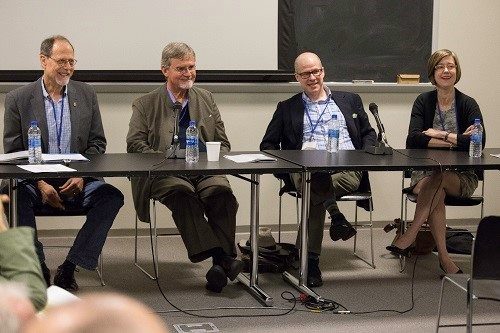2018 Conference Goers Take Home Useful Insights from Top Biographers
Below are reports on two of the panels that were offered at the Ninth Annual BIO Conference in May, written with assistance from John Grady. Each article continues on the BIO website. BIO members can read about seven more sessions in the July issue of The Biographer’s Craft; an archived copy is available in the Member Area.
You can see a photo gallery from the conference here.
Writing Multiple Lives
Lisa Cohen, author of All We Know: Three Lives, said she discovered that through a group biography she could dramatize her initial subject and anchor her in a community, a social circle. What tied together her three subjects—Esther Murphy, Mercedes de Acosta, and Madge Garland—was that they “were women who knew everybody” and their sexuality.
“I didn’t set out to write collective biography,” Carla Kaplan said when she started work on Miss Anne in Harlem: The White Women of the Black Renaissance. From her earlier biography on Zora Neale Hurston, Kaplan knew that many white women had connections to Hurston and others in the renaissance. As Kaplan delved deeper into the relationships those women had with Hurston and each other, she found “extraordinary dead ends” on how to approach writing about a single white woman in that time, in that place. Finally, Kaplan decided, “I am going to have to write that book to read that book” on the complexities of the relationships of the “Miss Annes”—a collective nickname—of being hostesses, philanthropists, snubbers of convention, and more.
Likewise, Justin Spring in The Gourmands’ Way: Six Americans in Paris and the Birth of a New Gastronomy had to work through “any number of false starts” to settle on how to proceed to write about six very different writers, who “were very much like the Americans of the ‘Lost Generation,’” in another era of “enormous American cultural ferment:” Paris after World War II.
Interesting as the six were as individuals, Spring said, “these people were not coming together” as a possible group biography until he found a key in Alice B. Toklas’s second book on cooking, and their shared love of French cuisine. Among the subjects in The Gourmands’ Way is Julia Child, to many Americans the doyenne of the Gallic way with food.
[more]

From left to right: Marc Leepson, Kai Bird, Max Boot, and
Heath Lee. Photo by Jane O’Connor
Writing About the Vietnam War
Moderator Marc Leepson, a Vietnam War veteran, began the session by providing some background. The Vietnam War was the longest U.S. war before the twenty-first century and the country’s most controversial overseas war. After the war, Leepson said, “Nobody really wanted to talk about it” because of its divisive nature. But as panelists Kai Bird, Max Boot, and Heath Lee showed, there is a market today for certain biographies relating to the Vietnam War era, even if there are challenges in writing them.
For Bird, one challenge was getting one of his subjects, McGeorge Bundy, to open up about his involvement in the war. Bird’s The Color of Truth: McGeorge Bundy and William Bundy: Brothers in Arms looked at the role both Bundy brothers played in setting U.S. policy toward Vietnam. Bird, a former Vietnam War protester, wanted to explore how smart, liberal intellectuals came to get America into and then defend the war. He was able to meet with both Bundys. William, he said, “was much more of a gentleman and a scholar” and more generous with his time. On the other hand, Bird said, “I feared Mac Bundy”—a man Bird once considered a war criminal. McGeorge was sometimes dismissive of Bird’s questions. The Color of Truth came out in 1991, and Bird said he had no trouble getting it published, but he was still dealing with his own anger about the war as he wrote it.
Both Max Boot and Heath Lee are of a younger generation than Leepson and Bird; their experiences of the Vietnam War were not nearly as direct. Boot said that with younger writers of Vietnam books “you lose some of that sense of immediacy” that came from authors writing just after the war. “But,” he added, “I think what you gain is some more perspective.” Boot brought that perspective to his recent biography of Edward Lansdale, the first complete look at the life of a military officer and CIA agent who helped shape U.S. policy toward Vietnam. Lansdale often appeared as a character in other books about the war, and Boot said he was usually presented in a one-dimensional way, as a con artist or malevolent figure. Boot wanted to present Lansdale in a more balanced way, while still presenting his flaws.
Heath Lee’s Vietnam book, The League of Wives: The Untold Story of the Women Who Took on the President, the Pentagon and the Rest of the US Government to Bring Their Husbands Home, which will be published April 2, 2019, is a group biography of civilians who have been overlooked: the wives of American POWs/MIAs. While writing the book, she said, she came to “love the ladies,” but she knew a biographer should not fall in love with her subjects. She interviewed most of the women featured, and they were eager to share a story that had not been told before. Another major source was the diary of Sybil Stockdale, one of the key figures in the book.
[more]
